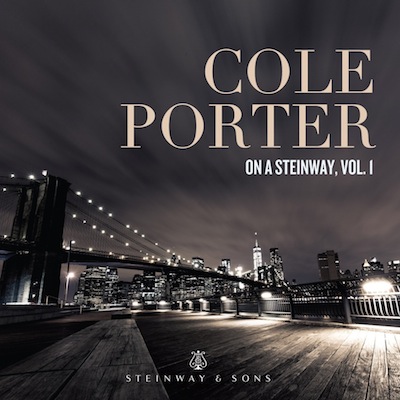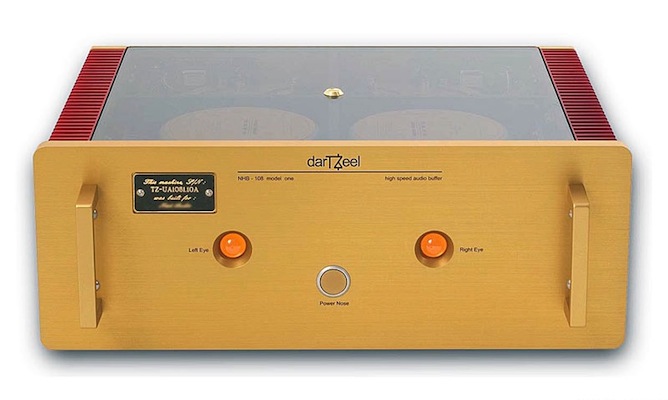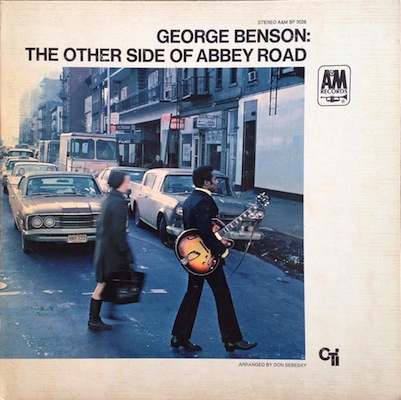
Author: John Marks
Cole Porter on a Steinway, vol. 1

Various: Cole Porter on a Steinway, vol. 1
Solo-piano transcriptions of show tunes by Cole Porter
Steinway & Sons catalog number 30116
Release date: December 6, 2019
Recorded at Steinway Hall, New York City, July 2014-April 2019.
Well, here’s a real winner!
Steinway & Sons’ piano recordings—especially the ones that they themselves produce and engineer at the new Steinway Hall performance and recording facility in New York City—are of reliably superb audio quality. That said, I hasten to point out that Steinway’s releases that were not recorded in Steinway Hall are often (but not always) just as good in terms of sound quality; they are merely “different.”
I think that the Steinway recordings made at the Shalin Liu performance hall in Rockport, Massachusetts are objectively as “good” as the Steinway Hall ones. Subjectively, I have a (slight) personal preference for the slightly more distant and bloom-y sound of Shalin Liu. If anyone prefers the slightly more in-focus Steinway Hall sound, I will not lose any sleep.
I also must point out that the sonic differences I am noting (and such is the case with many audio differences) are minor; they might not reveal themselves to casual listeners who only give a casual listen.
By this point, Steinway has released well over 100 CDs. Not all of them have totally won me over to their artistic standpoints (of course, such are matters of taste, and you are free to disagree). But… when the stars and planets line up as they do here… Wow!
This collection of solo-piano treatments of famous Cole Porter show tunes (by three different pianists, Adam Birnbaum, Jed Distler, and Simon Mulligan) presents, in spot-on high-resolution (24/96) sound, standout Cole Porter interpretations that range from the wistful and pensive to the liltingly bouncy. All delivered via sloshingly-full buckets of piano technique and always with a refined musical taste that might have made Cole Porter smile.
You can hear the entire album right now, at no charge via Steinway Streaming.
Cole Porter on a Steinway, Vol. 1 goes on sale December 6, 2019 (downloads only; mp3 on Amazon; 24/96 FLAC on HDTracks).
More pensations, and sound samples, after the jump. Continue Reading →
The Audio Equipment I Regret Not Having Bought, Way Back When (Part 1)
 darTZeel NHB-108 model one stereo power amplifier
darTZeel NHB-108 model one stereo power amplifier
Regrets, I have a few… even about reviewer-loan audio equipment I now wish I had bought, way back when.
The first audio magazine I wrote for was Wayne Green’s Digital Audio magazine. The première issue came out in September, 1984. The articles listed on the cover included “How to Buy Your First CD Player.” (Snort.) I was the founding classical-music columnist (“Classical ReMarks”).
I got that columnist job by pure happenstance. Someone I knew (Chuck Dougherty) worked for the regional hi-fi chain Tweeter, Etc. Chuck also was a computer whiz who moonlighted writing for one of Wayne Green’s computer magazines. Word got around to Chuck that Wayne Green Enterprises needed someone who knew about classical music, and who also could write. Seeing as I was already writing reviews of classical music concerts and recitals for the Providence Journal, I seemed to be a good fit. Wayne Green’s little publishing empire was based in New Hampshire. As it happened, I was visiting New Hampshire frequently, in that I was organizing and presenting the chamber-music performing-arts series at Thomas More College in Merrimac.
While writing for Digital Audio, I not only reviewed CDs and wrote a column; I also interviewed musicians, including André Watts, Michael Tilson Thomas, and Joseph Silverstein. Although my duties did not include equipment reviews, I did have occasion to drool over (or lust over) some pieces of gear. I moved on to the Planet HiFi website (which was where I first reviewed audio equipment, and not just recordings), and then back to print journalism, first with The Absolute Sound, and then Stereophile.
Please note, this mini-series is limited to products that I had the opportunity to hear in my home, as part of a formal review process. There are many excellent products I would consider buying, but which I just have not had the opportunity to hear at home; the best examples I can think of at the moment are the excellent radial loudspeakers from MBL.
After the jump, I recall some of the “big-fish” (as well as some “little fish”) audio-review-loan components that got away. Continue Reading →
Pyotr Ilyich Tchaikovsky – Hymn of the Cherubim (from the Liturgy of St. John Chrysostom, op. 41)
This YouTube music video has been viewed more than 5 million times (and there have been more than 3,500 comments posted), both of which indicate that people find that this music engages their emotions to a remarkable extent. Of course, I am speaking in the context of a genre (sacred classical music) that is a subset of a genre (classical music) that is, at best, a minority enthusiasm. What is classical music’s market share today? One source pegs classical’s share of “total music album consumption” (whatever that is) for the year 2018 at (drum roll, please): 1%.
In stark contrast, US rock band One Republic’s official YouTube music video for their single “Counting Stars” has had 2.8 BILLION views. Sigh.
I refuse to take heart from the fact that there is a genre that is even less popular than classical music, in part because that poor tattered remnant is what is left of New Age. Point five of one percent (0.5%)! But I am sure that the music on the above video would warm many a New Age heart. I have previously written and said, many times, that Renaissance Polyphony was the original “New Age” music. (I know—the above is not from the Renaissance, and also it doesn’t really contain much in the way of polyphony—what’s going on is more like slow-moving harmonies; but the spirit is the same.)
I think that there are many well-known composers (but of course there are also many exceptions to this little rule of mine) whose best-known work or works are not representative of the majority of their output. Furthermore, I believe that the better-known the most famous work is, the more likely is the case that the famous work doesn’t provide a ghost of a clue to the greatness of that composer’s best works. The poster child for this syndrome (of course) is poor Maurice Ravel, whose Bolero is… what it is… . That said, listening to Bolero, you would never guess that the same guy could write all of Le tombeau de Couperin; Miroirs; Daphnis et Chloé Suite no. 2; and Ravel’s String Quartet.
The same goes for Edward Elgar. “Land of Hope and Glory” is the soundtrack to a kindergarten “graduation” from a Peanuts animated special, which I think is a sly allusion to the number of “real” graduations where it can be heard. But nowhere in evidence in “Land of Hope and Glory” is the greatness of Elgar’s cello concerto, or his violin concerto, or his two symphonies. To say nothing of The Dream of Gerontius.
By now you might have guessed where I have been going with this. Tchaikovsky’s Overture “1812”—and The Nutcracker—almost everyone has to agree, don’t sound like they came from the pen of the chap who wrote the music in the video above. In Tchaikovsky’s “Hymn of the Cherubim” there is no bombast and no sugary cuteness. The entire Liturgy is worth your hearing it. After the jump, I will tell you what I have been able to learn about the recording on this video, and offer buying (or streaming suggestions). Continue Reading →
Steinway & Sons Streaming: An Excellent No-Cost Music Source
 Steinway & Sons’ Spirio Playback Piano.
Steinway & Sons’ Spirio Playback Piano.
Image courtesy of Steinway.
I felt a rueful twinge when legendary piano builder Steinway & Sons took itself private and as a result was de-listed from the New York Stock Exchange. My nostalgic or sentimental reason was that Steinway & Sons’ NYSE stock-ticker symbol long had been LVB, an homage to Ludwig van Beethoven. Beethoven’s piano sonatas are generally regarded as the distilled essence of greatness in piano music.
Apart from that, as far as I can tell, jumping out of the goldfish bowl that is the NYSE has done wonders for Steinway. In 2014, Steinway came out with the Spirio, a piano (available in two sizes) that includes the most sophisticated piano-playback technology (a non-MIDI system) ever to reach commercial critical mass. More recently, Steinway has begun offering a record-and-playback version of the Spirio. Steinway’s biggest challenge at the moment is building enough Spirio pianos to meet the demand. Good for them.
Under New Management, Steinway also launched their own CD label (they have also released a few SACDs). They embarked upon an ambitious recording agenda, for which they built a new, state-of-the-art performance-and-recording hall. So that you can hear the complete recordings before you buy the CDs or download the audio files, Steinway has created a dedicated streaming site that offers commercial-free play of complete albums from Steinway & Sons Recordings. There are also informative reviews posted for many of the albums. Steinway & Sons CDs are available from Amazon; hi-res files, from 24/44.1 to 24/192 (varying by title) are available from HDTracks.
I asked Eric Feidner, Steinway’s VP for Music, Media, and Technology, to tell me about what “getting into the record business” has meant for the 166-year old firm.
At Steinway, our very long history with performing artists goes back to the 1800s, with legendary pianists such as Anton Rubinstein and Ignace Paderewski. In recent decades, the “Steinway Artist” program has been a central part of the company. We started the record label about 10 years ago as a natural outgrowth of our relationships with Steinway Artists.
As we moved into the development of the Steinway Spirio, we faced a critical need to create a catalog of “high resolution” music to embed in the world’s finest player piano—we send our Spirio owners new playlists every month. Because there was no such content available elsewhere, we had to build our own. There are now close to 4,000 works in the Spirio catalog.
The Spirio piano’s development and the Spirio catalog’s development processes inevitably became symbiotic with the record label, as through these, we developed techniques to produce commercial audio recordings with far greater efficiency and with remarkably consistent levels of technical and sonic quality. Making recordings and building pianos are now very closely intertwined at Steinway & Sons.
After the jump, recommendations for a baker’s dozen (13) great CDs that you can hear in their entirety at no cost! Continue Reading →
George Benson: “The Other Side of Abbey Road”

The Beatles’ final studio album Abbey Road was released on LP in the United States on September 26, 1969. As will be discussed after the jump, audio-industry maven Philip O’Hanlon has pulled together (under the “Magnum Opus Rediscovered” banner) a coast-to-coast Abbey Road “listening party” for Saturday, September 28, 2019, in which 40 audio dealers will play the remastered album on “fine audio” (or “high end”) equipment, from 3:00 to 6:00 PM (local times).
Which is all fine and good. But I for one wish that the participating audio shops would extend the duration of their events by not all that much time (32 minutes), and spin what is to my mind, far and away, the best Abbey Road cover album ever, George Benson‘s woefully under-appreciated The Other Side of Abbey Road. Will they, won’t they? Matters not. It’s easy to add this gem to your collection!
Starting only three weeks after Abbey Road‘s US début (October 22-23 & November 4-5, 1969), producer Creed Taylor (who produced this record for Herb Alpert’s label A&M) convened a rather astonishing gathering of participating musicians at engineer Rudy van Gelder’s legendary studio. Don Sebesky was in charge of their comings and goings, in that he was the arranger. (Benson sang, as well as playing guitar.)
How’s this for an (incomplete) lineup? Ray Barretto, Ron Carter, Herbie Hancock, Freddie Hubbard, Bob James, Hubert Laws, Idris Muhammad, George Ricci (brother of Ruggiero Ricci), and Emanuel Vardi? More information (and sound samples) after the jump. Continue Reading →
Rick Beato: A Musical and Audio Analysis of Boston’s “More Than a Feeling”
Through Arturo Delmoni, I got to know Boris Goldovsky (1908-2001). I treasured our get-togethers and phone chats (and I also did some intellectual-property legal work for him). Although our acquaintance was, by most measures, rather fleeting, the time I spent with Mr. Goldovsky had an outsized effect on me. Just to shake hands with someone who, as a child, had fled Moscow with his mother during the October Revolution… . To say nothing of the fact that, before his small-‘e’ evangelical endeavors had had the result that, in the United States, his name would be inextricably intertwined with the concept of “Opera,” the young Boris Goldovsky’s piano teacher in Berlin had been Artur Schnabel.
Therefore, through Schnabel’s teacher Theodor Leschetizky, there are, in total, only four people shaking hands between Beethoven and me. (That’s because Leschetizky’s teacher Carl Czerny had been a student of Beethoven’s. So, the handshake chain goes: John Marks-(1) Mr. Goldovsky-(2) Schnabel-(3) Leschetizky-(4) Czerny-Beethoven.) And, not to lay it on too thick, but: the young Leschetizky’s concerto-début performance was conducted by… Mozart’s son.
Mr. Goldovsky’s claim to widespread fame (as distinct from his reputation among opera cognoscenti) was his intermission feature during the Saturday-afternoon live radio broadcasts of the Metropolitan Opera, which were sponsored by Texaco, the gasoline company. (He also hosted the “Opera Quiz” feature for a time.) Mr. Goldovsky would sit at the piano (a Knabe in a rehearsal room, which always made me well-disposed to that maker) and give a live “Musical and Dramatic Analysis of (the name of that Saturday’s opera).” Those features were brilliant, as well as witty. As examples, here he is on the operas Esclarmonde and Lulu.
I will never forget Mr. G’s quip that, for all his musical creativity, Wagner seemed not to have a clue about population genetics (a reference to the brother-sister twins Sieglinde and Siegmund’s being the incestuous parents of Siegfried). I think it fair to say that the consensus is that Mr. Goldovsky played a major role (and perhaps the major role) in making live performances of grand opera both comprehensible to and aspirational for the broad middle of American society, from the immediately post-WWII years though the 1980s. Mr. Goldovsky also deserves much credit for championing the cause of a young African-American singer, Robert McFerrin, who became the first African-American man to sing a title role at the Met, in 1955. (Robert McFerrin’s son Robert, Jr. took the professional name Bobby McFerrin.)
Courtesy of Jack Baruth‘s personal blog, I have now become virtually acquainted with Rick Beato (pr. “Bee-ah-to”); and let me say this:
What Mr. Goldovsky was to opera (the authoritative “explainer,” par excellence), Rick Beato is to rock-and-roll.
More, after the jump. Continue Reading →
Boston: “More Than a Feeling”
The rock band Boston’s 1976 breakthrough single, “More Than a Feeling” is a song about listening to a song. Or, more precisely, “More Than a Feeling” is a song about experiencing the cascade of emotions—nostalgia, regret, and longing—set in motion by listening to one specific song.
The “old” song the songwriter has been listening to is… “Walk Away Renée.”
Quel surprise!
The year 1976 was a great year for the stereo business. Thinking about the differences in “the industry” between then and now calls to mind L. P. Hartley’s elegant turn of phrase, “The past is a foreign country; they do things differently there.”
Looking back upon high-fidelity component audio’s market-share peak, Tech Hifi co-founder Sandy Ruby observed, “Electronics retailers felt better about themselves than they should have. In the glory days of audio, we were modestly successful businessmen, buoyed by a tidal wave.”
Before I turn my attention to the song at hand, I want to explore what went into building that tidal wave, so that where “More Than a Feeling” fit into it will make more sense. More, after the jump.
The Left Banke: “(Just) Walk Away Renée”
I remember when The Left Banke’s one-hit-of-wonder-ness “Walk Away Renée” was all over AM radio in the summer of 1966 (peaking at No. 5).
Featuring a classical string quartet (two violins, a viola, and a cello), a harpsichord, and an alto-flute solo on the bridge, it’s fair to say that “Walk Away Renée” sounded like nothing else on the charts at that time. To put this song into its contemporary context, the Beatles’ US television appearances on the Ed Sullivan show had been in February of 1964. So, by June 1966, the “British Invasion” (of the US music industry) was in full swing.
Silly me; until I recently began researching, I had assumed that the members of the group The Left Banke were British. (Because of the fey or twee spelling of “Bank” as well as their mop-top hair and “mod” clothing… .) However, it turns out that they were New Yorkers.
“Walk Away Renée” interests me for at least three reasons. One, it fits into my continued ruminations on the “Paradoxical Pleasure” of listening to sad songs. Secondly, “Walk Away Renée” was one of the first hit songs in the “Baroque Pop” genre. Thirdly, ten years later (in 1976), “Walk Away Renée” inspired a rock song that still gets lots of airplay today. (More on that in due course.)
There have been cover versions of “Walk Away Renée” recorded by The Four Tops, Southside Johnny, Rickie Lee Jones, Herman’s Hermits, Marshall Crenshaw, Sylvie Vartan, Vonda Shepherd, Badly Drawn Boy, Billy Bragg, and Ann Savoy with Linda Ronstadt. Rolling Stone, the L’Osservatore Romano of the rock era, declared “Walk Away Renée” to be the 220th “Greatest Song of All Time.” Pretty good for a rather small-scale song principally written by “Mike Brown,” a very lovesick 16-year old.
More after the jump.
Rita Payés and Elisabeth Roma: “A Rita”
Here’s an opportunity to celebrate excellence in various disciplines, and the greatness of the human spirit!
Every now and then I stumble upon a musical performance that just fills me with so much joy, and then I hasten to pass the word on. What a talented young lady, and what a talented mother she has! Before watching this, I would have wagered that the phrase “sensitive bass-trombone playing” included a contradiction in terms; but what a pleasure to be proven wrong.
Here, Rita Payés sings (in Portuguese) and plays trombone, while her mother Elisabeth Roma does a sterling job of accompanying on classical guitar the 1966 Bossa Nova song “A Rita.” “A Rita” is a break-up song that was on singer Francisco “Chico” Buarque de Hollanda’s first LP. Chico’s sister Heloísa Maria Buarque de Hollanda, BTW, married João Gilberto. She made her recording début on the (criminally underappreciated) Stan Getz/João Gilberto LP from 1976 The Best of Two Worlds. BTW2, the charming family name Buarque de Hollanda (I believe) means “Dutch Boat.”
BTW3, all praise and honors to the technical crew on this music video. The sound is pristine–whoever placed the microphone to capture the sound from the back of the trombone bell certainly knew what he or she was about. A spot mic pointed inside the bell would have been a disaster. No editing, no autotune, 100% organic—WNTL? (What’s Not to Love?)
Ms. Payés has an eye-wateringly expensive DSD-only SACD out (Amazon’s price is $64.99, but there are a few CDs left on eBay). Will somebody please fill the right people in on hi-res downloads, please? That outing includes Rhode Island native Scott Hamilton. Circa 1976 I heard him at Joe’s Upstairs in downtown Providence. Scott’s band back then was called the Hamilton-Bates Blue Flames. I’ve never heard any Scott Hamilton project that was less than inspired, so I hope that wider circulation can be made possible.
In the meantime, please spread the word about this perfect little YouTube!
# # #
EDIT AND APOLOGY: I goofed in reading too quickly and getting the idea that the eBay items were SACDs also. THEY ARE CDs. I wanted to get the blog post up quickly, and I made a mistake, and I apologize! I have changed the text above.
UPDATE: Acoustic Sounds now has the DSD-only SACD for $39.98. I have changed the link above to Acoustic Sounds, and here it is again.
A Very Persuasive Identification of the “Hidden Theme” of Elgar’s “Enigma” Variations
I am very grateful to Stereophile‘s John Atkinson for alerting me to an extraordinarily well-thought-out and, to me at least, persuasive identification of the “Hidden Theme” of Elgar’s “Engima” Variations.
Here’s the link to Ed Newton-Rex’s case that, when Elgar commented:
through and over the whole set [of variations] another and larger theme “goes”, but is not played
Elgar was referring to Pergolesi’s Stabat Mater. Details after the jump. Continue Reading →


